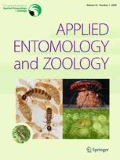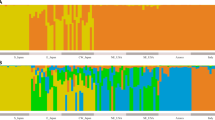Abstract
Ganaspis brasiliensis (Ihering) (Hymenoptera: Figitidae: Eucoilinae) is a Drosophila parasitoid that has often been misidentified as G. xanthopoda (Ashmead) in recent studies. This study aims to clarify genetic differentiation of G. brasiliensis based on the nucleotide sequences of the mitochondrial cytochrome oxidase subunit 1 (CO1) gene and three nuclear DNA regions, the inter-transcribed spacers 1 and 2 (ITS1 and ITS2) and putative 60S ribosomal protein L37 (RpL37), as well as crossing experiments. Four lineages are recognized in individuals assigned as G. basiliensis by morphology, (1) individuals occurring in Japan and probably South Korea, (2) individuals from a small subtropical island of Japan, Iriomote-jima, (3) individuals from temperate lowlands of Japan and high altitude areas of Southeast Asia, and (4) individuals occurring widely in Asia, America, Hawaii and Africa. The first lineage is a specialist of Drosophila suzukii (Matsumura), a pest of fresh fruit, and also the fourth lineage has a capacity to parasitize this pest species. The first, third and fourth lineages occur sympatrically at least in Tokyo. The third and fourth lineages differed in mate choice and host use to some extent, but post-mating isolation between them was almost absent.



Similar content being viewed by others
References
Ashmead WH (1896) Report on the parasitic Hymenoptera of the island of Grenada, comprising the families Cynipidae, Ichneumonidae, Braconidae, and Proctotrypidae. Proc Zool Soc Lond 63:742–812
Asplen MK, Anfora G, Biondi A et al (2015) Invasion biology of spotted wing Drosophila (Drosophila suzukii): a global perspective and future priorities. J Pest Sci 88:469–495
Baele G, Lemey P (2013) Bayesian evolutionary model testing in the phylogenomics era: matching model complexity with computational efficiency. Bioinformatics 29:1970–1979
Bouckaert R, Heled J, Kühnert D, Vaughan T, Wu C-H, Xie D, Suchard MA, Rambaut A, Drummond AJ (2014) BEAST 2: a software platform for Bayesian evolutionary analysis. PLoS Comput Biol 10:e1003537
Bruck DJ, Bolda M, Tanigoshi L, Klick J, Kleiber J, DeFrancesco J, Gerdeman B, Spitler H (2011) Laboratory and field comparisons of insecticides to reduce infestation of Drosophila suzukii in berry crops. Pest Manag Sci 67:1375–1385
Buffington ML, Forshage M (2016) Redescription of Ganaspis brasiliensis (Ihering, 1905), new combination, (Hymenoptera: Figitidae) a natural enemy of the invasive Drosophila suzukii (Matsumura, 1931) (Diptera: Drosophilidae). Proc Entomol Soc Wash 118:1–13
Carton Y, Boulétreau M, van Alphen JJM, van Lenteren JC (1986) The Drosophila parasitic wasps. In: Ashburner M, Carson HL, Thompson JN (eds) The genetics and biology of Drosophila, vol 3. Academic Press, New York, pp 347–394
Daane KM, Wang X-G, Biondi A et al (2016) First exploration of parasitoids of Drosophila suzukii in South Korea as potential classical biological agents. J Pest Sci 89:823–835
Darriba D, Taboada GL, Doallo R, Posada D (2012) jModelTest 2: more models, new heuristics and parallel computing. Nat Methods 9:772
Dobzhanski T (1965) “Wild” and “domestic” species of Drosophila. In: Baker HG, Stebbins GL (eds) The genetics of colonizing species. Academic Press, New York, pp 533–546
Drummond AJ, Ho S, Phillips M, Rambaut A (2006) Relaxed phylogenetics and dating with confidence. PLoS Biol 4:e88
Folmer O, Black M, Hoeh W, Luiz R, Vrijenhoek R (1994) DNA primers for amplification of mitochondrial cytochrome c oxidase subunit I from diverse metazoan invertebrates. Mol Mar Biol Biotechnol 3:294–299
Goto SG, Kitamura HW, Kimura MT (2000) Phylogenetic relationships and climatic adaptations in the Drosophila takahashii and montium species subgroups. Mol Phyl Evol 15:147–156
Kacsoh BZ, Schlenke TA (2012) High hemocyte load is associated with increased resistance against parasitoids in Drosophila suzukii, a relative of D. melanogaster. PLoS ONE 7:e34721
Kanzawa T (1939) Studies on Drosophila suzukii Mats. Yamanashi Agri Exp Sta Rep Kofu, Japan (in Japanese)
Kass RE, Raftery AE (1995) Bayes factors. J Am Stat Assoc 90:773–795
Kasuya N, Mitsui Y, Aotsuka T, Kimura MT (2013a) Diversity and host association of parasitoids attacking mycophagous drosophilids (Diptera: Drosophilidae) in northern and central Japan. Entomol Sci 16:227–234
Kasuya N, Mitsui H, Ideo S, Watada M, Kimura MT (2013b) Ecological, morphological and molecular studies on Ganaspis individuals (Hymenoptera: Figitidae) attacking Drosophila suzukii (Diptera: Drosophilidae). Appl Entomol Zool 48:87–92
Kimura MT (2015) Prevalence of exotic frugivorous Drosophila species, D. simulans and D. immigrans (Diptera: Drosophilidae), and its effects on local parasitoids in Sapporo, northern Japan. Appl Entomol Zool 50:509–515
Kimura MT, Suwito A (2012) Diversity and abundance of frugivorous drosophilids and their parasitoids in Bogor, Indonesia. J Nat Hist 46:1947–1957
Kimura MT, Suwito A (2015) Altitudinal patterns of abundances and parasitism in frugivorous drosophilids in west Java, Indonesia. J Nat Hist 49:1627–1639
Kimura MT, Ohtsu T, Yoshida T, Awasaki T, Lin FJ (1994) Climatic adaptation and distributions in the Drosophila takahashii species subgroup (Diptera: Drosophilidae). J Nat Hist 28:401–409
Lemeunier F, Tsacas L, David J, Ashburner M (1986) The melanogaster species group. In: Thompson JR, Carson HL (eds) The genetics and biology of Drosophila, vol 3. Academic press, New York, pp 147–256
Lohse K, Sharanowski B, Stone GN (2010) Quantifying the pleistocene history of the oak gall parasitoid Cecidostiba fungosa using twenty intron loci. Evolution 64:2664–2681
Mitsui H, Kimura MT (2010) Distribution, abundance and host association of two parasitoid species attacking frugivorous drosophilid larvae in central Japan. Eur J Entomol 107:535–540
Mitsui H, Van Achterberg K, Nordlander G, Kimura MT (2007) Geographical distributions and host associations of larval parasitoids of frugivorous Drosophilidae in Japan. J Nat Hist 41:1731–1738
Paradis E, Claude J, Strimmer K (2004) APE: analyses of phylogenetics and evolution in R language. Bioinformatics 20:289–290
R Core Team (2015) R: a language and environment for statistical computing. R Foundation for Statistical Computing, Vienna, Austria. https://www.r-project.org/. Accessed 17 August 2015
Rambaut A, Suchard MA, Xie D, Drummond A (2014) Tracer ver. 1.6. http://beast.bio.ed.ac.uk/Tracer. Accessed 1 May 2015
Ranbaut A (2014). FigTree ver. 1.4.2. http://tree.bio.ed.ac.uk/software/figtree. Accessed 13 February 2015
Schilthuizen M, Nordlander G, Stouthamer R, van Alphen JJM (1998) Morphological and molecular phylogenetics in the genus Leptopilina (Hymenoptera: Cynipoidea: Eucoilidae). Syst Entomol 23:253–264
Schulmeister S, Wheeler WC, Carpenter JM (2002) Simultaneous analysis of the basal lineages of Hymenoptera (Insecta) using sensitivity analysis. Cladistics 18:455–484
Tamura K, Petersen D, Petersen N, Stecher G, Nei M, Kumar S (2011) MEGA5: molecular evolutionary genetics analysis (MEGA) using maximum likelihood, evolutionary distance, and maximum parsimony methods. Mol Biol Evol 28:2731–2739
Untergasser A, Cutcutache I, Koressaar T, Ye J, Faircloth BC, Remm M, Rozen SG (2012) Primer3—new capabilities and interfaces. Nucl Acid Res 40:e115
Acknowledgments
We thank M. Kondo and M. B. Lankim who provided us with Ganaspis specimens from Kinabalu, and T. I. Kohyama, G. Kinoshita, and H. Suzuki for their advice and assistance in the molecular and phylogenetic analyses. This study was supported by Grant-in-Aids from the Japan Society for the Promortion of Science (No. 23370005) and also performed as a part of the Dropsa Project. The USDA does not endorse any commercial product mentioned in this research. USDA is an equal opportunity provider and employer.
Author information
Authors and Affiliations
Corresponding author
Rights and permissions
About this article
Cite this article
Nomano, F.Y., Kasuya, N., Matsuura, A. et al. Genetic differentiation of Ganaspis brasiliensis (Hymenoptera: Figitidae) from East and Southeast Asia. Appl Entomol Zool 52, 429–437 (2017). https://doi.org/10.1007/s13355-017-0493-0
Received:
Accepted:
Published:
Issue Date:
DOI: https://doi.org/10.1007/s13355-017-0493-0




